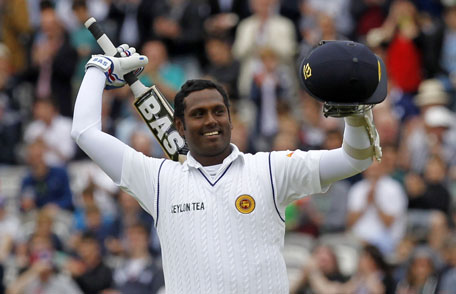
Atreyo Mukhopadhyay
The average Indian cricket fan heard the name of Angelo Mathews in 2009. He played one match for Kolkata Knight Riders (KKR) in the Indian Premier League (IPL)that year. The all-rounder had represented Sri Lanka in a few ODIs and was yet to be picked in the Test side, when he was made a part of Shah Rukh Khan’s caravan, as a back-up for misfiring Australian Moises Henriques.
That this white-ball all-rounder finished his Test career as the third-highest run-scorer for his country shows what value he added to his team. He is also fourth on the list of most-capped Sri Lankans with 118 appearances. Mahela Jayawardene, Kumar Sangakkara and Muthiah Muralitharan are the ones ahead of him. That’s exalted company for any cricketer, irrespective of nationality.
The player from Colombo, who turns 38 on June 2, was an all-format and all-weather cricketer for his team. He dropped anchor, played the aggressor, avoided bowling in Tests due to injury concerns and still took 126 ODI wickets with his medium-pace. He also captained the team in a difficult time for cricket on the island and played a true all-rounder’s role in Sri Lanka’s T20 World Cup triumph in 2014, when they beat India in the final in Dhaka.
However, to understand the real worth of this unassuming and soft-spoken cricketer, it’s important to examine the period in which he performed. By the time Mathews found his feet in international cricket, Jayawardene and Sangakkara were on their way out. Tillakaratne Dilshan was fading. Chaminda Vaas and Murali had retired earlier. There was suddenly a dearth of talent in Sri Lanka.
Mathews didn’t have success in Australia and South Africa, but made runs in England and New Zealand. He seemed to reserve his best while playing in England and led Sri Lanka to a historic series win in 2014. The captain made centuries in both Tests. Under him two years later, Sri Lanka inflicted a 3-0 whitewash on Australia at home.
The best of Mathews came after the decades when Sri Lankan batters were among the best in the world or just one rung below. The names include Duleep Mendis, Roy Dias, Arjuna Ranatunga, Aravinda De Silva, Sanath Jayasuriya, Jayawardene, Sangakkara and Dilshan. The difference between them and him was that they had company. Mathews was mostly waging a lone battle with the bat.
To do that for nearly 16 years, making 8167 runs at 44.62 with 16 centuries and 45 fifties, and lead a deteriorating Test team was no mean task. That average is better than Cheteshwar Pujara, Rohit Sharma and Ajinkya Rahane. Yet, Mathews is not celebrated outside his home confines. Factoring in the team’s achievements in a player’s assessment is a cruel practice at times.
Mathews was from that generation which adapted to white-ball cricket and excelled in those formats without shifting focus from Tests. Like illustrious Sri Lankan batters, this is another vanishing breed. With him retiring from this format after a Test against Bangladesh in Galle starting on June 17, his country will find it hard to fill in a gap which Mathews himself shielded with distinction.



